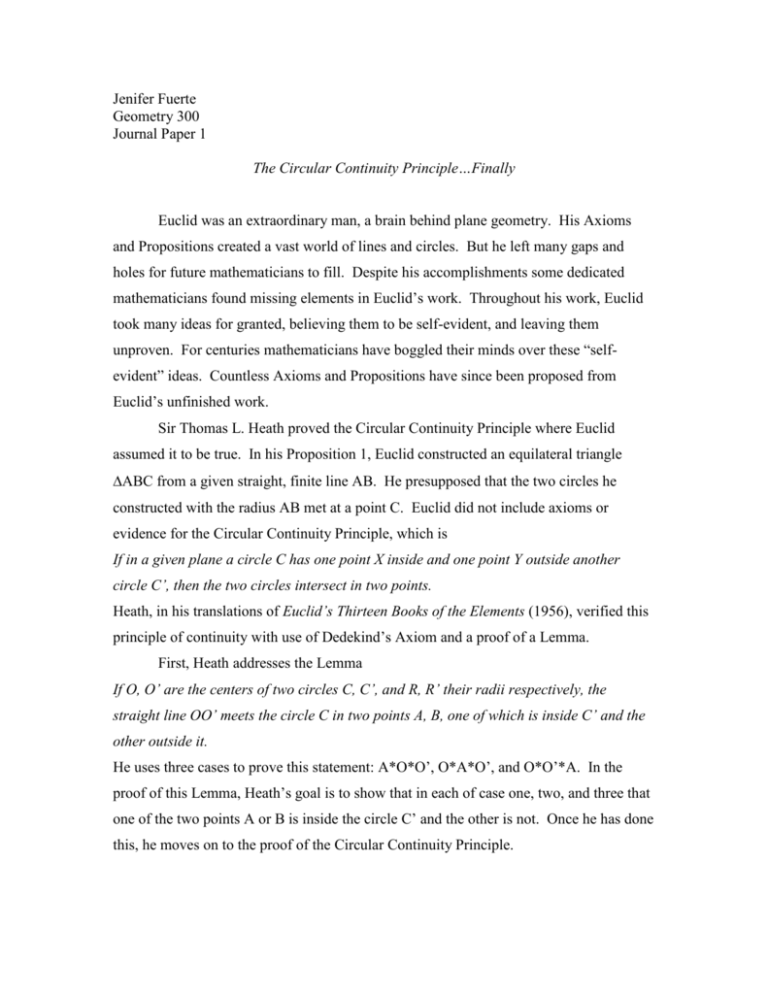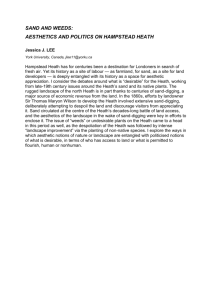Jenifer Fuerte
advertisement

Jenifer Fuerte Geometry 300 Journal Paper 1 The Circular Continuity Principle…Finally Euclid was an extraordinary man, a brain behind plane geometry. His Axioms and Propositions created a vast world of lines and circles. But he left many gaps and holes for future mathematicians to fill. Despite his accomplishments some dedicated mathematicians found missing elements in Euclid’s work. Throughout his work, Euclid took many ideas for granted, believing them to be self-evident, and leaving them unproven. For centuries mathematicians have boggled their minds over these “selfevident” ideas. Countless Axioms and Propositions have since been proposed from Euclid’s unfinished work. Sir Thomas L. Heath proved the Circular Continuity Principle where Euclid assumed it to be true. In his Proposition 1, Euclid constructed an equilateral triangle ABC from a given straight, finite line AB. He presupposed that the two circles he constructed with the radius AB met at a point C. Euclid did not include axioms or evidence for the Circular Continuity Principle, which is If in a given plane a circle C has one point X inside and one point Y outside another circle C’, then the two circles intersect in two points. Heath, in his translations of Euclid’s Thirteen Books of the Elements (1956), verified this principle of continuity with use of Dedekind’s Axiom and a proof of a Lemma. First, Heath addresses the Lemma If O, O’ are the centers of two circles C, C’, and R, R’ their radii respectively, the straight line OO’ meets the circle C in two points A, B, one of which is inside C’ and the other outside it. He uses three cases to prove this statement: A*O*O’, O*A*O’, and O*O’*A. In the proof of this Lemma, Heath’s goal is to show that in each of case one, two, and three that one of the two points A or B is inside the circle C’ and the other is not. Once he has done this, he moves on to the proof of the Circular Continuity Principle. To begin this proof, Heath started with two intersecting circles C and C’, with centers O and O’ and radii R and R’ respectively. Heath began with a circle C and, with points A and B on the diameter, divided it into two semicircles. He placed point A on segment OO’. He then takes two separate points P and Q on the circle C such that A precedes P, P precedes Q, and Q precedes B along the semicircle. P Q O’ B O A C C’ By Betweenness Axiom 3, we have points A*P*Q and P*Q*B along the semi-circle, which we will refer to as semicircle APQB. He then proceeded to compare the triangles OO’P, OO’Q. By Congruence Axiom 2, the triangles have segment OO’ congruent. Segments OP and OQ are congruent by definition of a circle. He found, however, that O’P O’Q due to the fact that angle POO’ was less than angle QOO’. He knew that these angles were not equal by claiming that ray OP is between rays OQ and OO’, which followed from P preceding Q. Now here is where Heath brought in Dedekind’s Axiom. He first considered that the semicircle containing points A, P, Q, B was divided into two parts, where the points of the first part were inside circle C’ and the rest of the points were outside the circle C’. By Dedekind’s Axiom, Heath claimed that there exists a point M on C’ separating the two parts of semicircle APQB. The point M was also the intersecting point on circle C, by Dedekind’s Axiom. M B O’ O A To prove that O’M = R’, or point M was on the circumference of C’, Heath used a proof by contradiction. By RAA hypothesis, he supposed that O’M R’, placing point M interior to circle C’. He assigned as the difference between R’ and O’M, using as a placeholder. Heath next selected a point M’ following point M on the semicircle, making sure that the chord MM’ was less than . (He takes necessary steps to place point M’ between points M and B on the semicircle.) M’ M B O’ O A Then, by taking the triangle O’MM’, Heath claimed that O’M’ O’M + MM’ O’M + or, by Proposition 3.13, O’M’ R’. Heath concluded that the point M’ would be a point on the arc MB and inside the circle C’. However this contradicted the notion that arc MB was the “second part” in Dedekind’s Axiom, where he constructed the point M to be the point of intersection of circle C’ and arc APQB, separating the arc into two parts. Since we move along the arc from A to B, any point on arc MB would be outside circle C’. Next Heath claimed that it might be proved that O’M is not greater than R’ with another RAA Hypothesis. Though he does not show the proof, he implies that another contradiction leads to O’M = R’. This completed the proof of the existence of one of the points of intersection between circles C and C’. Heath must also repeat the process for the other semicircle of C. Once he does this, he has proven that the two circles intersect in two points. Heath completed a part of geometric theory that Euclid felt was self-evident. Principles of Continuity become important to mathematicians filling the gaps in Euclid’s Elements. W. Killing, in his book Einfuhrung in die Grundlagen der Geometrie, produced sufficient claims, stating that points moving along a form, such as a line or arc, that is divided into two parts will eventually reach the boundary between the two parts. In the book Elementi di Geometria (1905), Enriques and Amaldi came up with Propositions stating the relationship between points on two circles in relation to the lengths of their radii and the distance between their origins, using in their proofs some of the same Postulates as Euclid. Their Proposition 5, which was similar to the Circular Continuity Principle, stated If the distance between the two centers of two circles is less than the sum, and greater than the difference, of the radii, the two circumferences have two common points symmetrically situated with respect to the line of centers but not lying on that line. This Proposition showed that there exist two points of intersection between two circles that have sections of their circumferences within the other circle. These men, like Heath, have filled the holes Euclid’s assumptions have left in geometry. Bibliography Euclid, The Thirteen Books of Euclid’s Elements, Translated by Sir Thomas L. Heath, Volume 1, (New York: Dover Publications, Inc., 1956), 234-243. Euclid, The Thirteen Books of Euclid’s Elements, Translated by Sir Thomas L. Heath, Volume 2, (Cambridge: University Press, 1926), 30-32. Greenberg, Marvin J., Euclidean and Non-Euclidean Geometries: Development and History, (New York: W. H. Freeman and Co., 1993), 70-114.






